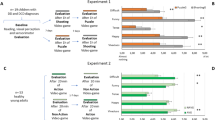Abstract
It is argued that what we call intelligent behavior is based to a great extent on our ability to analyze multimodal and crossmodal information. Acquisition and utilization of those functions seem to appear and develop greatly during the 2–4 year period in humans. Among the functions are those frequently affected in dyslexic persons. It might be possible to diagnose potential dyslexics by testing for the adequacy of those functions at that early period. In addition, limitations on the number of concepts that can be handled simultaneously may be involved in information processing in such a way as to affect both multimodality and crossmodality; this limitation seems not to be generally taken in to account by educators, especially those working with dyslexic persons.
Similar content being viewed by others
References
Adams, and Victor, 1981.Principles of Neurology. New York: Figure 27–1
Case, R. and Serlin, R. 1979. A new processing model for predicting performance on Pascual-Leone’s test of M-space.Cognitive Psychology 11:308–326.
Dobbing, J. and Sands, J. 1973. Quantitative growth and development of human brain.Archives of Diseases of Childhood 48:757–767.
Eiseley, L. 1957.The Immense Journey. New York: Random House.
Epstein, H. T. 1974. Phrenoblysis: special brain and mind growth periods. I. Human brain and skull development; II. Human mental development.Developmental Psychobiology 7:207–224.
Epstein, H. T. 1978. Growth spurts during brain development: implications for educational policy and practice.In J. S. Chall and A. F. Mirsky (eds.).Education and the Brain. Chicago: University of Chicago Press.
Epstein, H. T. 1979. Correlated brain and intelligence development in humans.In M. E. Hahn, C. Jensen, and B. Dudek (eds.).Development and Evolution of Brain Size: Behavioral Implications. New York: Academic Press.
Epstein, H. T. 1980. Some Biological Bases of Cognitive Development.Bulletin of the Orton Society 30:157–177.
Galaburda, A. and Kemper, T. 1979. Cytoarchitectonic abnormalities in developmental dyslexia: a case study.Annals of Neurology 6:94–100.
Geschwind, N. 1968. Disconnection syndromes in animals and man.Brain 88:237–294.
Ingvar, D. H. 1976. Functional landscapes of the dominant hemisphere.Brain Research 107:181–197.
LeVay, S. and Stryker, M. 1979. Ocular Dominance Columns in the Cat. Society for Neuroscience. Symposium Volume IV. Bethesda, MD. Figures 4 and 6.
Pascual-Leone, J. 1969. Doctoral dissertation, University of Geneva.
Patterson, P. 1983. Introduction to “The Development of Synapses”. In:Annual Review of Physiology. New York: Annual Reviews 45:549–551.
Vygotsky, L. 1962.Thought and Language. Cambridge, MA: M.I.T. Press.
Author information
Authors and Affiliations
Rights and permissions
About this article
Cite this article
Epstein, H. Multimodality, crossmodality, and dyslexia. Annals of Dyslexia 35, 35–49 (1985). https://doi.org/10.1007/BF02659179
Issue Date:
DOI: https://doi.org/10.1007/BF02659179




